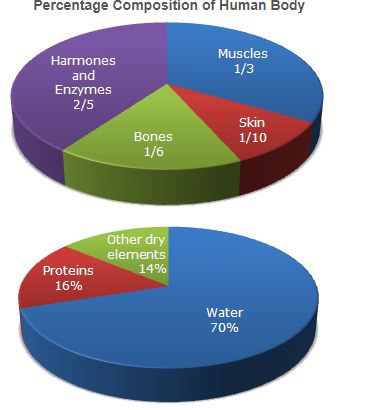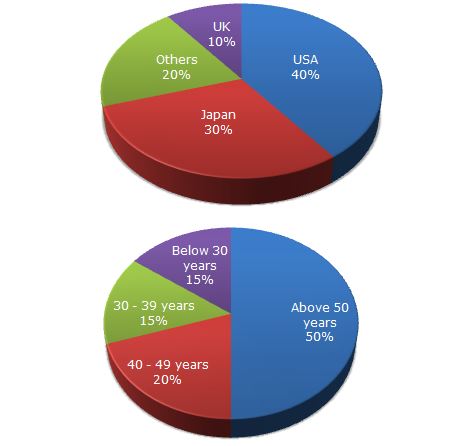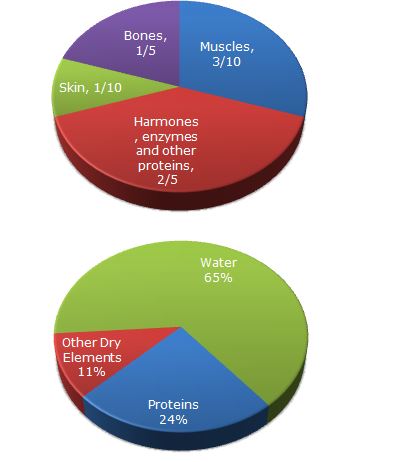 Introduction
Introduction
Data Interpretation is the ability to analyze, interpret and visualize the provided data to arrive at conclusions and to make inferences. Data Interpretation questions in the competitive exams is a test of analytical abilities. In the competitive exams, the Data Interpretation questions are grouped together and refer to the same table, graph or other data/visual presentation. The test takers are required to interpret or analyze the given data to answer the questions. In India, competitive exams related to employment in Banking, SSC, Insurance, etc..have the Data Interpretation type of questions.
 Quiz
Quiz
Directions(1-5): Study the following pie-diagrams carefully and answer the questions given below it:
1. What percent of the total weight of the human body is equivalent to the weight of the proteins in the skin in the human body?
- A. 0.016
B. 1.6
C. 0.16
D. Data inadequate
- A. 20 kg
B. 35 kg
C. 41 kg
D. 42.5 kg
- A. 1 : 18
B. 1 : 2
C. 2 : 1
D. 18 : 1
- A. 54°
B. 126°
C. 108°
D. 252°
- A. [latex]\frac{1}{40 }[/latex]
B. [latex]\frac{3}{80 }[/latex]
C. [latex]\frac{2}{2 }[/latex]
D. None of these
Directions(1-5): The following pie-chart shows the percentage distribution of the expenditure incurred in publishing a book. Study the pie-chart and the answer the questions based on it.
Various Expenditures (in percentage) Incurred in Publishing a Book
1. If for a certain quantity of books, the publisher has to pay Rs. 30,600 as printing cost, then what will be the amount of royalty to be paid for these books?- A. Rs. 19,450
B. Rs. 19,450
C. Rs. 22,950
D. Rs. 26,150
- A. 15°
B. 24°
C. 54°
D. 48°
- A. Rs. 36
B. Rs. 37.50
C. Rs. 42
D. Rs. 44.25
- A. Rs. 187.50
B. Rs. 191.50
C. Rs. 175
D. Rs. 180
- A. 5%
B. 33[latex]\frac{1}{5}[/latex]
C. 20%
D. 25 %
Directions(1-3): The following pie charts exhibit the distribution of the overseas tourist traffic from India. The two charts shows the tourist distribution by country and the age profiles of the tourists respectively.
Distribution of Overseas Tourist Traffic from India.
1. What percentage of Indian tourist went to either USA or UK ?- A. 40 %
B. 50 %
C. 60 %
D. 70 %
- A. 2:1
B. 8:3
C. 3:8
D. Cannot be determined
- A. 18.75 lakh
B. 25 lakh
C. 50 lakh
D. 75 lakh
Distribution of Weight in Human Body
4. What percentage of proteins of the human body is equivalent to the weight of its skin ?- A. 41.66 %
B. 43.33 %
C. 44.44 %
D. Cannot be determined
- A. 40 %
B. 50 %
C. 60 %
D. 70 %
Other Articles
 Study Guide
Study Guide
| Competitive Exams - Study Guide | ||
|---|---|---|
| Category | ||
| Quantitative Aptitude | Reasoning Ability | General Awareness |
| Computer Awareness | English Knowledge | Banking Awareness |
| General Science | World of Words | Descriptive Test |
 Exams
Exams
| Competitive Exams - College Entrance Exams | |||
|---|---|---|---|
| Category | Notification | ||
| Diploma | Goa Diploma Admissions 2019 | ||
| Click Here For – All India Entrance Exam Notifications | |||
 Daily CA
Daily CA
 Job-Alerts
Job-Alerts
 SP Quiz
SP Quiz
| Competitive Exams - Practice Sets | |
|---|---|
| Category | Quiz |
| Quant Aptitude | Puzzles |
| Current Affairs | Current Affairs |
 GK
GK
| General Knowledge for Competitive Examinations | |
|---|---|
| Topic | Name of the Article |
| GK - World | Countries Independence Day |
| Important Battles – World History | |
| GK - India | Awards and Fields |
| Indian Political Parties | |
| GK - Abbreviations | Science Information Technology Abbreviations |
| Indian Government Policies Abbreviations | |
| GK - Banking & Insurance | Capital Market in India |
| First Banks in India | |
| GK - Science & Technology | Human Body Facts |
| Chemical Elements | |









